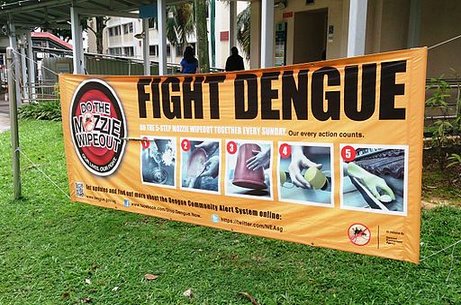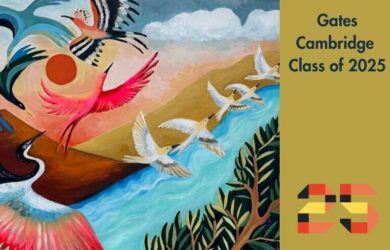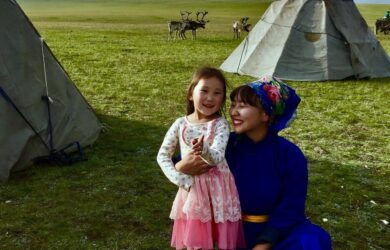
After suffering from dengue fever, Leah Katzelnick began researching the disease and is now attempting to map the interaction between different strains of the virus.
Leah Katzelnick was all set for a career as an anthropologist until she contracted dengue fever. She was in hospital for a week with severe symptoms. It changed her life. She is now the only scientist focusing solely on dengue fever at the University of Cambridge, working in partnership with the National Institutes of Health to map the interaction between different strains of the virus, all enabled by a Gates Cambridge Scholarship.
Dengue outbreaks are common in many developing countries. Four billion people live in areas with the disease, although mortality is relatively low. There are 400m infections a year. Only 500,000 people develop severe infection symptoms and approximately 25,000 of these die. However, it places a huge burden on the health services of countries where there are major outbreaks. “Epidemics can swamp public health and intensive care services,” says Leah [2012]. “It creates fear even if there is a low likelihood of death and in many countries virtually everyone knows someone who has died from it, most of whom are children.”
For her PhD she has been working with both human and non-human primate sera. Isolates from some of the main strains of the dengue virus are injected and Leah studies the immune sera to chart the complex inter-relationship between the four main strains of the virus. Dengue only causes mild infection in the non-human primates she works with.
Early years
Leah, from Madison, Wisconsin, was not sure what she wanted to study at university initially. She was interested in maths, music and history and was a keen participant in musical theatre at school. She was also interested in social justice issues and organised a teach-in about Darfur after getting to know the Sudanese husband of a local pastor.
At Williams College, where she did her undergraduate studies, she joined up with a friend who was interested in Uganda and the two organised several initiatives for eastern Africa, including book drives. She also joined Students for Social Justice and was involved in a hunger banquet and an alternative gift fair.
Leah had thought she would study pre-med and major in maths, but she found anthropology and English captured her imagination more. However, although she graduated with a major in anthropology she did pre-med throughout and became more and more interested in science, particularly virology.
In her second year she travelled to Nicaragua to hear people’s stories and try to understand the kind of issues they were facing. She had been studying a course on dilemmas around humanitarian interventions and how well-meaning interventions had failed due to a lack of understanding of the lives of those in receipt of aid.
In her third year she did a study abroad summer fellowship programme on international health to learn about different health systems and beliefs about health. It involved talking to people in NGOs about their aims and talking to people on the ground about how the NGOS were perceived. She travelled to Nicaragua again and lived with a family there who had good contacts with people working in international organisations. She started contacting different organisations and talking to people in the community.
Dengue
Then she contracted dengue fever and became very sick. “I was wandering Managua by myself talking to people asking them what the problems were with international organisations which seemed quite strange since I was a white North American. People were understandably quite suspicious of me and I came to a sad realisation that I might not be able to overcome that, even with the best of intentions. At least one organisation saw young North American students as a burden. I was the thing I was studying. It was emotionally challenging and I wondered if what I was doing was worth it. Was I harming the community just by being there? Then I got dengue fever and I felt even more of a burden,” she says.
She had no idea how sick she was, but the family she was staying with could see she wasn’t well. Her temperature had rocketed and she was taken to a government clinic. “There is no cure for dengue and only the symptoms can be treated. In the most mild cases dengue is asymptomatic. Normally people suffer from joint ache, headaches, pain behind the eyes and a strange rash on the hands. In the most extreme cases they suffer from haemorrhagic fever and a rapid drop in platelet count and blood pressure which can cause the body to go into shock. Children who go into shock have a high mortality rate, but if they get good healthcare they can survive,” says Leah.
She spent a week in hospital being monitored for possible shock. Her vascular system was so traumatised afterwards that she felt very weak. “I was a good runner, but it took weeks to go for a normal run and I was still very slow,” she says.
Afterwards she says she became obsessed with dengue fever since it was such a big emotional experience. It also caused her to rethink her future. If you have been exposed to dengue fever before you are more likely to suffer the more extreme form the next time round. As an anthropologist she would want to travel and mainly to places where there was dengue fever, but she did not want to risk getting it again.
Leah applied for a fellowship from Williams College to study in the UK and wanted to do virology before applying to medical school, but not having a science background, she thought she would have to stick to qualitative research.
She opted to study public health and development studies at Cambridge and began looking at how people rate their own health. She was still interested in dengue, though.
She contacted dengue experts and spent the summer before coming to Cambridge in a dengue laboratory in North Carolina estimating transmission of dengue fever in Sri Lanka.
Mapping dengue
Once at Cambridge she researched if anyone was studying dengue fever and the only person she came across who mentioned it was Professor Derek Smith who was studying infectious disease in the zoology department. She was thrilled as she read his paper on antigenic cartography and the evolution of flu viruses and felt it could be applied to the four different types of dengue and the complex interaction between those types. She wanted to design an antigenic map for dengue which would show the relationship between the different viruses and how having one might protect you from having that same strain again while having the others could make your feel worse.
She emailed Professor Smith and put her proposal to him. He said there was no funding for a project on dengue. However, Leah’s fellowship allowed her to switch the focus of her studies after a year. That meant she could get funding for a year. She then applied to do a PhD to continue her work and for a Gates Cambridge Scholarship to support her. “The Gates Cambridge money was instrumental to letting me keep working on dengue,” she says. “It was only because Professor Smith’s website mentioned dengue fever that I found this technique and a new way of thinking about dengue.”
Leah began her PhD in 2012 and hopes to complete it next year. She has been working round the clock on her research and says it was initially terrifying since her background was in anthropology rather than lab-based science. Since then she has been presenting her findings at international meetings such as the World Health Organisation and has submitted a paper for review to a top journal.
Leah plans to keep working on dengue after her PhD is completed and to better understand the human immune response to dengue virus infection so that scientists can limit its impact.
Picture credit of educational banner hung up in residential neighbourhoods to teach residents how to prevent dengue in Singapore: Project Manhattan and Wiki Commons.












